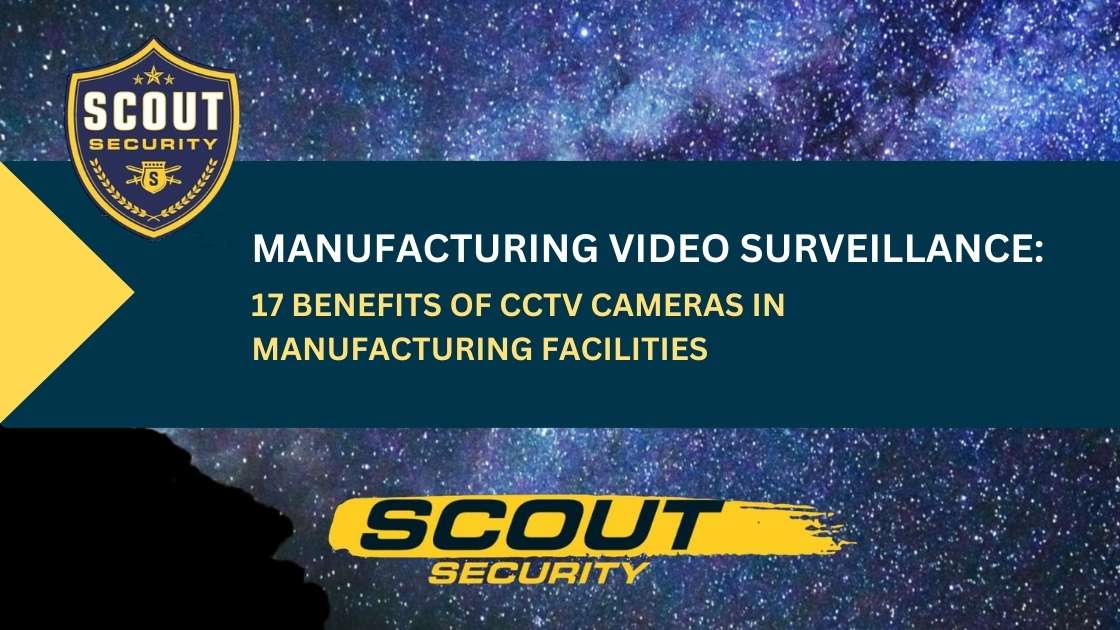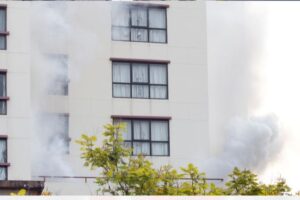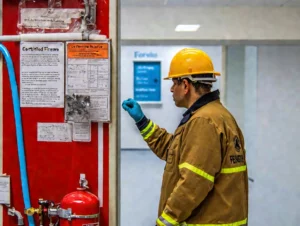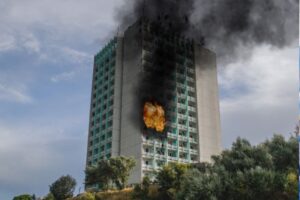Remote video surveillance in the industrial and manufacturing industry prevents theft (internal and external) and other criminal activities in your factory, plants, or mills. It also helps resolve incidents quickly and disprove false claims through CCTV footage that can help with investigations. Costly workplace accidents and liabilities can also be prevented.
All of these will protect your expensive assets (e.g. raw materials, finished products, equipment), and operations to optimize productivity and ensure quick ROI.
Scout Security can help boost the efficiency of your manufacturing operations and loss prevention strategies through live video surveillance in the Denver Metro and Colorado Springs areas. We have certified CCTV operators and use advanced technology for smart monitoring to give your facility comprehensive protection. Book a consultation now!
What Is Manufacturing Video Surveillance?
Manufacturing video surveillance involves using CCTV cameras and AI for advanced analytics to monitor your plants in real-time. It can boost your facilities’ security while reducing costs and enhancing production efficiency by providing effective perimeter protection. This allows for early detection of intruders, breaches, and other suspicious activities that can compromise the safety of your plant.
Also Read: What Is CCTV Monitoring and How Does It Work?
17 Benefits of Video Surveillance in Manufacturing
In summary, below are what your business will get when you implement video surveillance in your manufacturing facility:
- 24/7 Coverage of Multiple Sites
- Effective Access Control
- Theft and Loss Prevention
- Improve Operational Efficiency
- Prevent Workplace Accidents
- Ensure Regulatory Compliance
- Documentation for Investigations
- Avoiding False Liability Claims
- Safe and On-Time Delivery of Goods
- Spot Retraining Gaps
- Reduced False Alarms
- Remote Video Monitoring
- Live Video Surveillance
- Faster Intrusion Detection
- Proactive and Real-Time Response
- Reduced Labor Costs
- Lower Insurance Premiums
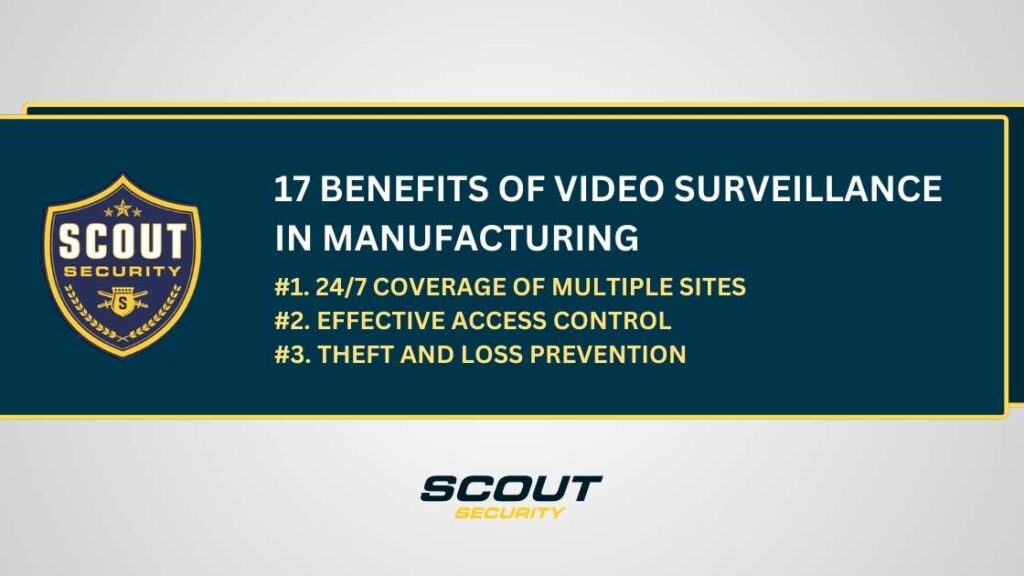
#1. 24/7 Coverage of Multiple Sites
For manufacturers needing video monitoring across multiple locations, security camera systems allow offsite viewing of live feeds.
Strategic camera placement is crucial for covering all parts of your property, indoors or outdoors, to optimize visibility.
Professional video surveillance companies will install CCTVs in high-risk areas, especially those that need to comply with health and safety guidelines, and position them to maximize coverage in the following:
- Manufacturing and assembly areas
- Raw materials delivery zones
- Storage rooms
- Loading docks
- Product dispatch areas
- Parking garages
- Entrances and exits
- Machinery operations
- High-voltage spots
- Restricted areas
- Office areas
- Roofs
Helpful Tip: Use cloud-based servers to ensure continuous recording and prevent downtimes. Consider night vision cameras, too, to ensure visibility in low-light conditions and capture footage even in the dark.
#2. Effective Access Control
Video surveillance systems can be integrated with access control systems to enhance facility monitoring and management.
Since manufacturing facilities experience a constant influx of legitimate visitors, it is important that you control access to sensitive areas like loading docks and dispatch bays. Additionally, only certain employees should be authorized to enter specific areas.
Installing CCTV cameras at entry points will allow for video and audio verification to limit entry to authorized personnel only.
Also Read: 21 Benefits of Remote Real-Time Video Monitoring for Businesses: A Comprehensive Guide
#3. Theft and Loss Prevention
Manufacturing video surveillance can also help with your loss prevention strategy through the following:
- Discouraging Illegal Activities: Manufacturing sites face theft risks at various stages. Cameras at entrances, exits, and vulnerable areas can help mitigate this risk.
- Preventing Internal Theft: It can deter employee misconduct and help control access to restricted areas to ensure the safety of your assets from internal theft. It can also help resolve theft incidents quickly by reviewing recorded footage to identify the involved individuals.
- Preventing External Theft: Visible security cameras can deter potential intruders and thieves. Surveillance systems can also alert your management and security team once a threat is detected to minimize damage to your goods. Moreover, audio warnings can be given to detected intruders to make them flee from your premises before they can commit any crime.
- Reducing Inventory Shrinkage: Monitoring the movement of materials and products and ensuring that high-value goods are secured through video surveillance will minimize misplacement and theft further.
Helpful Tip: Choose weatherproof (e.g. IP68-rated cameras) and vandal-proof cameras that are resilient against tampering for outdoor monitoring to ensure reliable surveillance in harsh environments.
Also Read: Inventory Shrinkage: Causes and Ways to Prevent It in Retail Settings and Warehouses
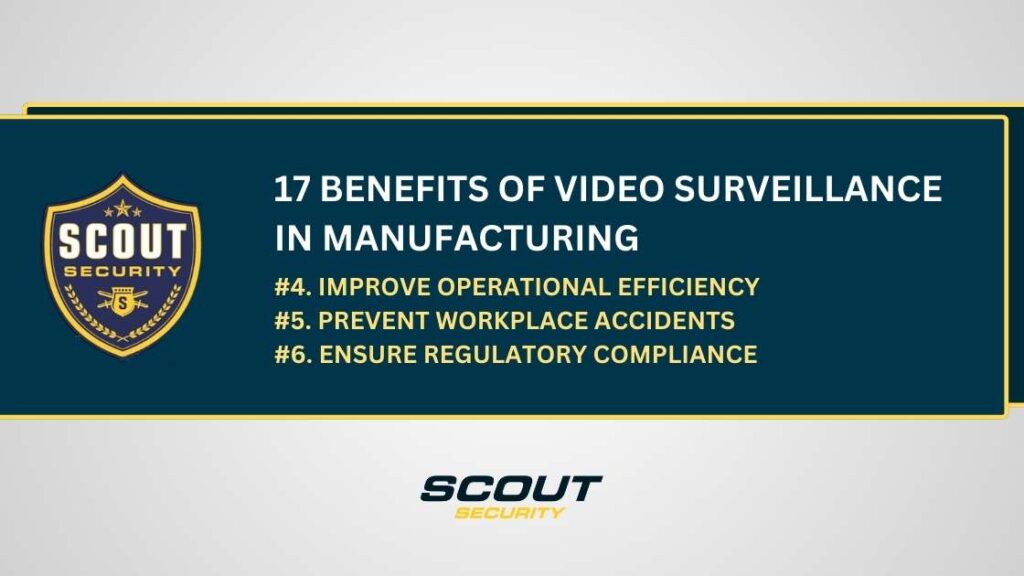
#4. Improve Operational Efficiency
We understand that maximizing productivity is the main goal of manufacturing businesses. Machinery failures and other productivity issues can cause significant setbacks which could lead to customer dissatisfaction and lost profits.
Video surveillance helps oversee your entire production process and increase productivity by:
- Monitoring Production Operations
Video monitoring offers real-time surveillance of your property, employees, and product movement to identify bottlenecks, inefficiencies, and optimization opportunities. With this, managers can promptly address these issues to improve operational flow.
- Minimizing Downtime
CCTV systems, combined with technologies like thermal imaging sensors, can detect potential issues like machine overheating early. This allows for proactive measures to reduce factory downtime and maintain high productivity levels.
Also Read: 23 Benefits of Outsourcing Video Monitoring and Surveillance Services
#5. Prevent Workplace Accidents
Employers are responsible for creating a safe workplace for their employees to avoid costly OSHA violations, lawsuits, and expenses associated with worker accidents (e.g. medical expenses and productivity loss).
The manufacturing industry, including industrial sites and factories, is one of the most dangerous industries for workers because they house dangerous machinery with many moving parts which increases the risk of fatal accidents.
These accidents can range from sprains and soreness to more serious injuries like lacerations and fractures caused by:
- Exposure to harmful environments or substances
- Being struck or caught in by equipment or object
- Falls, slips, and trips
CCTV surveillance can help mitigate workplace hazards and ensure worker safety with the help of operators through the following:
- Identifying safety hazards and potential threats
- Detecting unsafe practices (e.g. unsafe distance from machinery)
- Monitoring machinery and accident-prone areas
- Ensuring compliance with safety procedures
- Providing footage for safety reviews and post-incident analysis
- Helping implement corrective actions to prevent future incidents
- Integration with audio systems to warn employees
#6. Ensure Regulatory Compliance
We’ve mentioned that video surveillance can prevent worker accidents by ensuring your compliance with health and safety requirements. In addition to this, CCTV cameras can encourage the adherence of your employees to safety protocols knowing that they are being observed.
CCTV monitoring also provides visual data on your actual operations which makes detecting and addressing compliance issues easier.
Also Read: Warehouse Theft Prevention: 19 Best Surveillance Practices
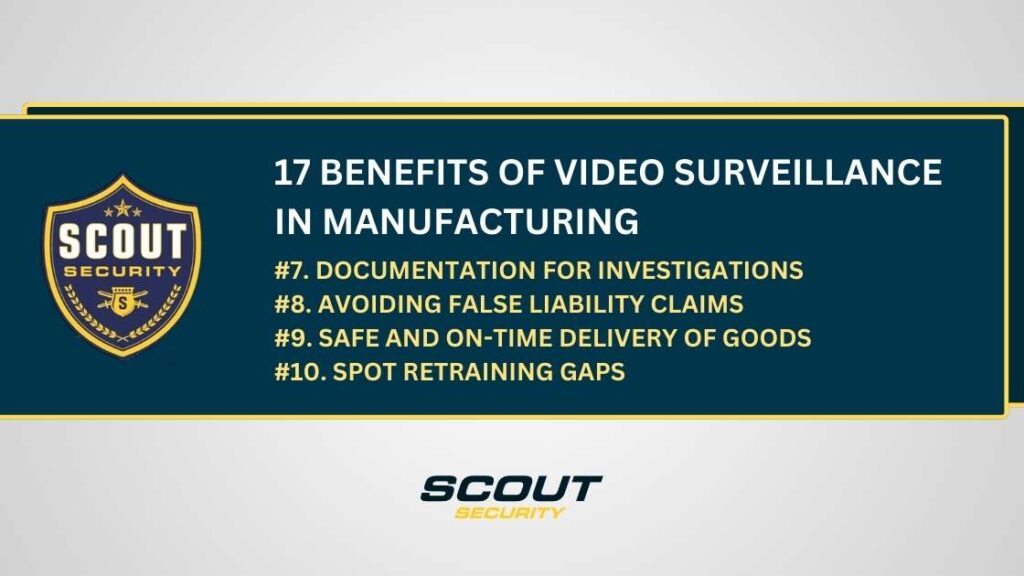
#7. Documentation for Investigations
High-definition recording is important to get clear evidence for resolving incidents.
Integrated video surveillance systems provide 24/7 coverage and document crimes inside and outside your facility which can help with law enforcement investigations to catch culprits. It can also document safety violations and employee activities in case of legal issues.
#8. Avoiding False Liability Claims
Video monitoring can also help determine if an accident was due to employer negligence or employee error.
Moreover, analyzing video footage can identify safety gaps and recurring issues after the incident so you can implement effective corrective actions like more signage, protective barriers, or equipment upgrades to prevent future incidents.
#9. Safe and On-Time Delivery of Goods
CCTV monitoring also offers transparency into your shipping timelines by providing your suppliers access to selected footage to help them know when materials are low and if they should be making new shipments.
Moreover, video surveillance also safeguards the delivery of raw materials and other products to ensure that they arrive on time. Thus, preventing supply chain delays. You can also get notified when new deliveries are made.
Also Read: 25 Common Video Surveillance Mistakes to Avoid
#10. Spot Retraining Gaps
Video surveillance isn’t just for catching bad behavior. It’s also a valuable tool for safety training, remedial education, and employee coaching.
Retraining needs often go unnoticed in manufacturing and can lead to decreased productivity. CCTV surveillance systems can help identify these gaps by spotting recurring errors that indicate where training is needed.
For instance, video analytics can highlight specific areas of underperformance which can guide you in designing targeted retraining programs. It can also help address issues like time theft and safety lapses caused by shortcuts.
In addition, surveillance footage provides an excellent resource for demonstrating proper task execution which gives your new employees clear examples of best practices.
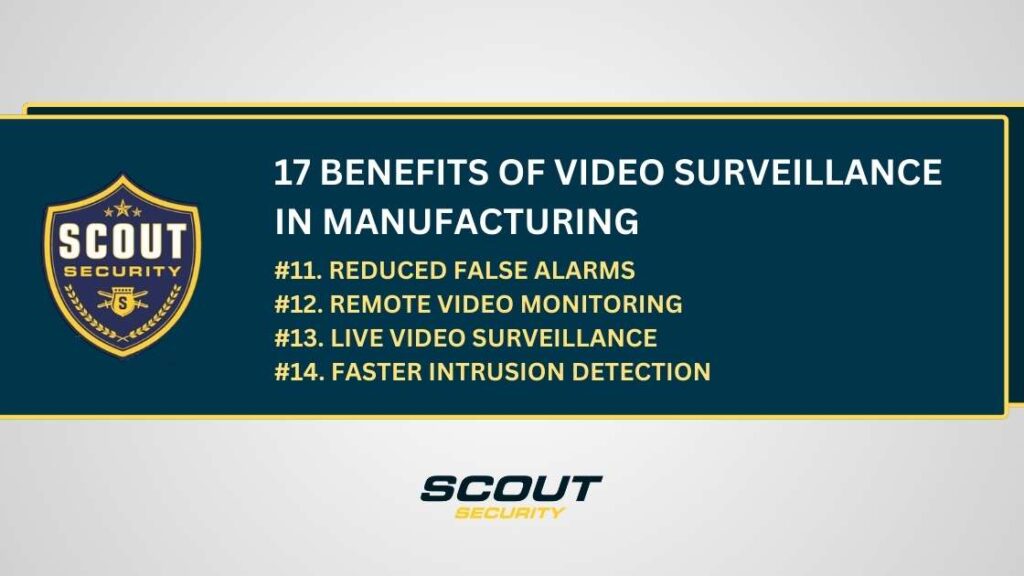
#11. Reduced False Alarms
Alarm verification enables real-time incident review to ensure accurate emergency responses and optimize resource allocation.
Video analytics powered by AI can distinguish between false alarms (like moving machinery and foliage being blown by the wind) and real human activity (moving people and vehicles). This ensures only relevant alarms reach your security team.
With fewer false alarms, you can also save on fines and your staff can prioritize critical tasks by reducing their workload involving the verification of pointless false alarms.
#12. Remote Video Monitoring
You can view live feeds from multiple sites on your premises remotely whether it is to monitor compliance or conduct off-site inspections yourself.
Cloud-based CCTV systems allow you to view footage from any secure location and access historical footage easily for review purposes.
#13. Live Video Surveillance
Live video surveillance can replace or supplement physical security guards which offers cost savings while ensuring continuous monitoring.
Installing CCTV cameras throughout your manufacturing plant is great, but you should not stop there. Many companies fail to have personnel actively monitoring the cameras which can pose liability risks.
Remote monitoring with video analytics and trained operators watching live video feeds can significantly enhance the ability to detect incidents before they occur. Without active monitoring, video surveillance becomes passive and ineffective in deterring crime.
#14. Faster Intrusion Detection
A robust surveillance system can prevent both physical and network intrusions by capturing footage of trespassing, suspicious behavior, and unauthorized access to areas with sensitive data. Thus, preventing cybersecurity breaches.
Also Read: 19 Effective Retail Loss Prevention Strategies and Best Practices
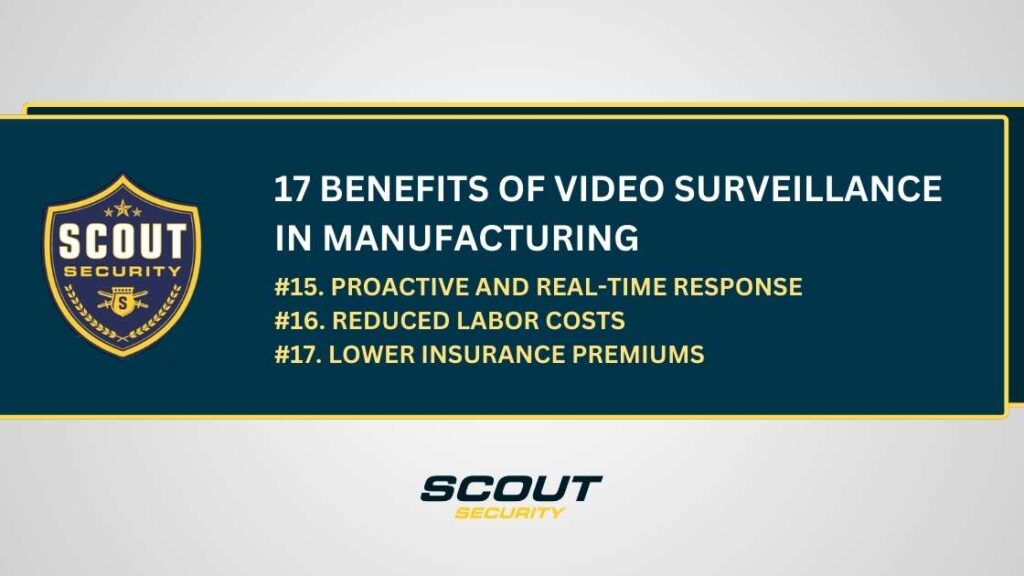
#15. Proactive and Real-Time Response
Live remote video monitoring can proactively prevent crimes before they happen, unlike traditional solutions that are reactive and will only respond after an incident has occurred.
Modern solutions that combine video surveillance with intrusion detection devices increase the chances of intruders being detected before they can commit any crime. Examples of these devices are motion-activated alarms, motion sensor lights, card readers, biometric systems, PIN code access, and others.
It also allows for the early resolution of minor issues in your production line including safety issues to prevent them from escalating into major disruptions. For instance, video analytics combined with the vigilance of operators can detect when your key metrics have fallen outside the norms.
Since safety hazards and causes of delays (e.g. delays in loading/unloading trucks, equipment failures) can be identified earlier, they can also be addressed as soon as possible to ensure operational continuity.
Smart CCTV systems also trigger real-time alerts for critical incidents.
Notifications when breaches happen can be automatically sent to your on-site team who can respond to the issue immediately. Thus, allowing for effective apprehension of perpetrators.
Also Read: Security 101: Types of Commercial Security Systems & How to Choose
#16. Reduced Labor Costs
If you are a small business and want to save on your security expenses, a comprehensive CCTV system that is monitored in real-time by certified operators can help you. These operators can perform virtual site patrols and can monitor multiple areas at the same time which can reduce required on-site security guards. This means that you won’t have to worry about additional salary and training expenses for hiring new security guards.
#17. Lower Insurance Premiums
Lastly, insurance companies often offer discounts for businesses that show a strong commitment to security. Since video surveillance can lower security risks, you might also get lower insurance premiums.
Also Read: A Complete Guide: How Much Do Remote Video Monitoring Services Cost?
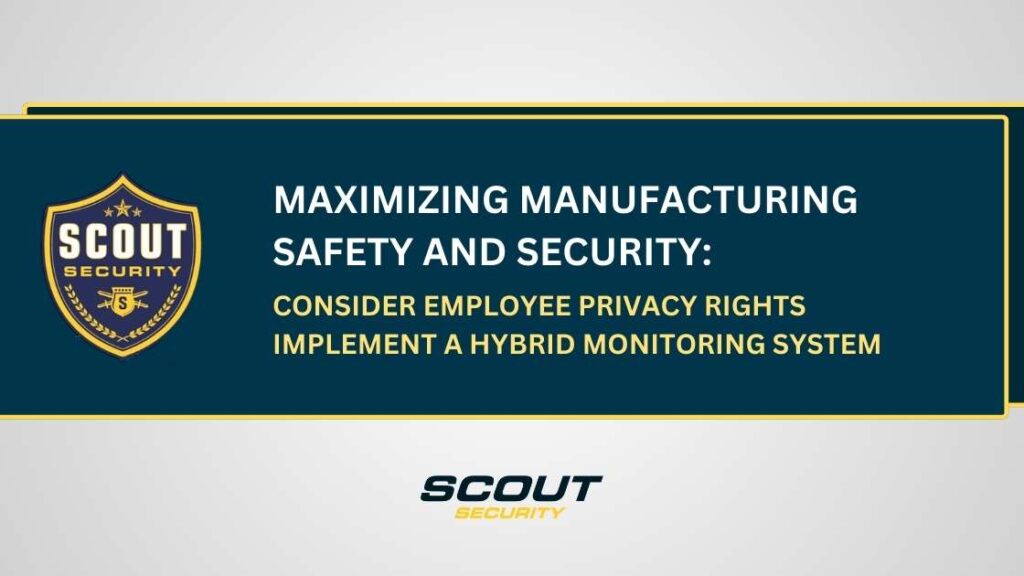
Important: Consider Employee Privacy Rights
Consulting a licensed video surveillance company, like Scout Security, is advisable for professional guidance and support regarding employee monitoring through CCTV.
Depending on your state and local privacy laws, employers are often given limitations to how far they can go with monitoring their employees. For instance, some states do not require you to inform your employees that you are monitoring them while some regulations may also require employee consent.
Generally, you can conduct video surveillance in areas where privacy is not expected like entrances and common areas. It is strictly prohibited to install CCTV cameras in locker rooms and bathrooms because you might face legal issues.
Maximizing Manufacturing Safety & Security: Implement a Hybrid Monitoring System
Video monitoring should not be used as a complete security solution on its own if you want comprehensive coverage. You should combine it with other security measures to enhance threat detection and response as well as improve workplace safety.
These measures include the following:
- Proper signage (e.g. danger and caution signs)
- Machine guarding (e.g. physical barriers enclosing dangerous machine parts)
- On-site security guards (to eliminate the limitations of video surveillance and initiate faster incident response)
- Employee safety training (includes proper use of equipment and machine guards)
Also Read:
FAQs
Security cameras ensure workplace safety to prevent employee accidents by monitoring accident-prone areas and helping identify and address potential hazards early. This, in turn, prevents costly legal issues and liabilities.
You should only use video surveillance in the workplace for legitimate purposes like preventing theft, addressing workplace violence, monitoring performance, and overseeing employee misconduct. Consider employee privacy rights when implementing CCTV monitoring to avoid legal issues.
The key advantages of CCTV cameras in warehouses include the following:
– Enhancing security 24/7, especially during off-hours
– Preventing unauthorized access
– Spotting potential hazards (e.g. fire hazards)
– Perimeter intrusion detection
– Compliance with safety laws and SOPs
– Detecting machine malfunctions
Scout Security Offers Robust Manufacturing Remote Video Surveillance Services
Scout Security uses smart CCTV systems to ensure effective video monitoring of your manufacturing plant in the Denver Metro and Colorado Springs areas. We help you optimize efficiency and ensure workplace safety at cost-effective rates to give you quick ROI.
We conduct risk assessments to tailor our solutions to your specific needs, so you can rest assured that you get comprehensive security coverage to prevent safety violations and criminal attacks. Book a consultation now!

